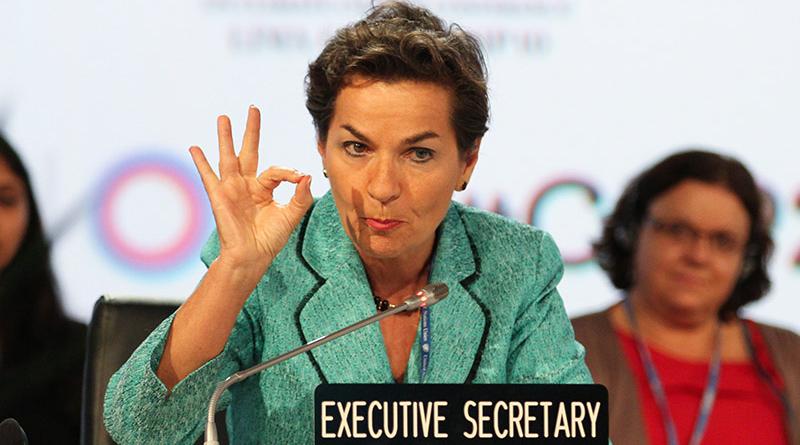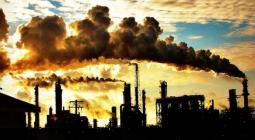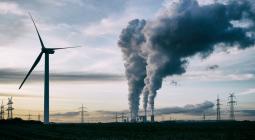After five years, here are five things the Paris Agreement achieved — and didn’t

The Paris Agreement has survived the US withdrawal and normalised net zero, but emissions are still rising and vulnerable people are suffering from climate disasters.
In the early hours of 13 December, 2015, Christiana Figueres walked into a sports bar in Paris and down the steps to the dance floor. The cheers were deafening.
Climate campaigners, negotiators and journalists were letting off steam, after a fortnight of intense negotiations had yielded a long overdue international climate pact.
The Costa Rican diplomat who led the UN climate body was greeted as a hero. Arms around each other’s shoulders, the throng belted out the Queen hit “We are the champions”.
Those self-proclaimed champions of the climate did not always look like they were winning in the five years that followed.
Yet as the anniversary of the Paris Agreement rolls around, there is a sense of renewed hope in multilateralism to close the gaps between ambition and action.
Here are five things the Paris Agreement has achieved — and five things still to work for.
1) Political resilience
There is no doubt that president Donald Trump withdrawing the US from the Paris Agreement was a body blow.
For his four-year term, the world’s second highest emitter would not pull its weight in carbon cuts, giving cover to others to slack off.
But the move did not, as some feared it would, lead to an exodus of like-minded nationalists from the pact. Even Jair Bolsonaro, Brazil’s deforester-in-chief, was persuaded to stay in. The US stood alone — and is set to rejoin under president-elect Joe Biden.
The structure of voluntary national contributions and a common accountability framework, with an ambition “ratchet” every five years, is working more or less as intended.
In parallel, the French presidency of Cop21 made a big deal of engaging with business and subnational leaders, who in some cases made up for a lack of national action.
2) Normalising 1.5C
One of the biggest surprises of Paris was the inclusion of 1.5C as an aspirational limit on global temperature rise.
Long demanded by the most vulnerable island states as essential to their survival, 1.5C had previously been brushed aside as infeasible by bigger powers. 2C was the moderate, reasonable target.
The Intergovernmental Panel on Climate Change was invited to produce a special report on the science of 1.5C. Published in 2018, it reinforced the difference half a degree would make to millions of lives.
Official recognition of 1.5C did not make it any less of a long shot to get there. But it shifted the onus away from proponents of 1.5C having to defend its feasibility, to proponents of 2C having to defend sacrificing vulnerable communities.
3) Normalising net zero
Net zero emissions is fast becoming a buzzword of 2020, with China, Japan and South Korea joining the EU and UK in setting carbon neutrality goals.
This trend has its roots in the Paris Agreement. It got less attention than the temperature goal at the time, obscured as it was by jargon, but signatories did agree to ultimately go carbon neutral.
The aim is “to achieve a balance between anthropogenic emissions by sources and removals by sinks … in the second half of the century”.
It translates the global warming limit into a more practical milestone, with implications for investments today.
If you are aiming for zero in 30 years, it makes no sense to build a polluting coal plant, oil pipeline or LNG terminal with a typical lifespan of 40 years or more.
4) Clean energy shift
The financing landscape has shifted decisively in favour of clean energy.
Paris sent the signal that clean technology improvements were a worthwhile — and safe — investment, while fossil fuels were increasingly risky. This year’s coronavirus crisis reinforced the message.
In spring 2015, former UN climate chief Yvo de Boer said coal plants were still the “logical choice” for developing countries. In 2020, the notoriously conservative International Energy Agency hailed wind and solar power as more resilient than fossil fuels to a Covid-induced demand slump.
Asian financial institutions are starting to follow their western counterparts in blacklisting coal, a stance recently endorsed by China’s environment ministry.
Clean energy supermajors are overtaking oil companies in terms of market value. Forecasters are naming earlier dates for peak oil demand, with some in the industry entertaining the idea demand may never return to pre-pandemic levels.
5) Institutional change
The Paris Agreement has no central enforcement mechanism. That does not mean it is unenforceable.
Institutions ranging from financial regulators to city authorities are embedding the deal’s targets and principles in their policies, creating new avenues for accountability.
More than 400 public development banks committed to align their activities with the Paris deal and a handful of Asian hold-outs are under increasing pressure to follow suit.
The EU has made compliance with Paris a condition of every free trade agreement struck since 2015 — and Brazil’s backsliding on deforestation is a potential barrier to ratification of its deal with the Mercosur bloc.
Lawyers are citing the deal in court cases around the world. And in the UK, they are testing whether it can be used to block the expansion of Heathrow Airport.
But. Any sense of optimism about the progress driven by the Paris deal must be tempered by the harsh reality of how far there is to go. Here is what has yet to change.
1) Rising emissions
Global greenhouse gas emissions have continued to grow, with a billion tonnes of CO2 added to annual figures between 2015 and 2018.
The trend is dominated by emerging economies in Asia, as incumbent energy industries meet a hunger for development by any means.
A plateau in China’s emissions from 2014-16 raised hopes of decoupling its economic growth from pollution, but the numbers then resumed their rise.
Advanced economies are not cutting emissions fast or consistently enough to offset growth elsewhere.
A drastic reduction in travel and economic activity across much of the world for several months of 2020, to curb the spread of coronavirus, is only projected to cut global energy-related CO2 emissions by 7% year-on-year.
That pace would need to be sustained in the absence of a deadly pandemic to meet the 1.5C goal.
2) Rising temperatures
As emissions rise, so too do temperatures. 2020 is set to be 1.2C warmer than pre-industrial times and among the three hottest years on record, despite the cooling effect of La Nina.
The word “unprecedented” keeps coming up in weather coverage. Wildfires in the Arctic. Cyclones hitting parts of Africa that are not prepared. Droughts and floods confounding subsistence farmers the world over.
Scientists have got more confident and assertive about attributing these extremes to global heating. In the case of one deadly Japanese heatwave in 2019, modellers found it simply would not have happened without human influence on the climate.
The atmosphere will keep serving up new records for generations. Temperatures will not stabilise until emissions reach net zero, because carbon dioxide builds up in the air.
3) Rising fossil fuel production
The phrase “fossil fuels” does not appear in the Paris Agreement. Nor do the words “coal”, “oil” or “[methane] gas”.
To meet the Paris goals, the vast majority of hydrocarbons need to stay in the ground — but that was too blunt a reality to concede for countries economically reliant on them.
While the coronavirus crisis has cast considerable uncertainty over the future for coal, oil and gas markets, many governments are doubling down on polluting sectors.
Producers have a perverse incentive to exploit their reserves quickly while they still can — a clearance sale. That carries risks for workers, communities and citizens dependent on oil revenues, as well as for the climate.
With Paris ill-equipped to address this dynamic, some are calling for an Opec-style deal for a managed decline of fossil fuel production.
4) The vulnerable suffer
Within and between countries, it is poor and marginalised people who are most exposed to the climate crisis.
The Paris Agreement is not all about cutting emissions. It covers adapting to the impacts of climate change and acknowledges that some people will experience loss and damage that cannot be mitigated against or adapted to. It calls on developed countries to support poorer nations with finance, technology and training.
Climate finance flows from rich governments have increased on the face of it. But the majority is delivered as loans, not grants, adding to the debt burden of developing countries. Greening growth in middle income countries eternally takes priority over protecting the poorest from a problem not of their making.
There is no compensation for victims of climate disaster, only talking shops and insurance schemes they must pay the premiums for.
More solidarity is needed to make the deal work for vulnerable communities.
5) International transport gets away
Early drafts of the Paris Agreement explicitly called on the UN bodies responsible for international aviation and shipping to set sectoral emission reduction targets and policies to deliver them. That text did not make the final cut.
The International Civil Aviation Organization (Icao) and International Maritime Organization went on to negotiate climate deals, but neither are aligned with a 1.5C or 2C global warming limit.
Initial steps to implement those deals further watered down ambition, while ICAO lashed out at climate critics on social media.
In both forums, industry dominates while civil society observers and media operate under tight restrictions. Policymakers belong to the same elite class as frequent flyers, while shipping is out of sight, out of mind.
The two sectors’ carbon footprint, currently around 5-6% of global emissions, is set to grow and will increasingly stand out in the absence of stronger action.
9 December 2020
climate home news




